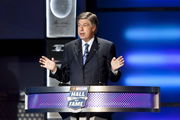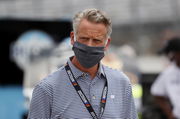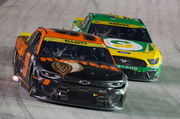
via Getty
INDIANAPOLIS, IN – AUGUST 13: NASCAR driver Kyle Larson talks to the media about doing the Double of running the 2024 Indianapolis 500 and the 2024 Coca Cola 600 in the same day in a press conference held before the start of the NASCAR Cup Series Verizon 200 at the Brickyard on August 13, 2023, at the Indianapolis Motor Speedway Road Course in Indianapolis, Indiana. (Photo by Brian Spurlock/Icon Sportswire via Getty Images)

via Getty
INDIANAPOLIS, IN – AUGUST 13: NASCAR driver Kyle Larson talks to the media about doing the Double of running the 2024 Indianapolis 500 and the 2024 Coca Cola 600 in the same day in a press conference held before the start of the NASCAR Cup Series Verizon 200 at the Brickyard on August 13, 2023, at the Indianapolis Motor Speedway Road Course in Indianapolis, Indiana. (Photo by Brian Spurlock/Icon Sportswire via Getty Images)
If you thought last year’s Indianapolis 500-Coca-Cola 600 doubleheader was a nail-biter, brace yourself for what’s coming next. Kyle Larson’s ambitious attempt to pull off the iconic “double” turned heads, but it also triggered a seismic shake-up in NASCAR’s rulebook. This new regulation, now dubbed the “Kyle Larson Rule,” could leave drivers facing devastating consequences should they try anything similar in the future.
Racing insider Jeff Gluck didn’t hold back when he broke down the implications of NASCAR’s revised waiver policy, hinting at a rule that has serious teeth. So, what’s changed? Why has Kyle Larson’s daring feat now become a cautionary tale for those with desires to race outside NASCAR mid-season?
ADVERTISEMENT
Article continues below this ad
What is the ‘Kyle Larson rule’? Jeff Gluck explains
The new playoff waiver rule has sent ripples through the NASCAR community. Jeff Gluck was quick to elaborate: “Well, while NASCAR has decided to encourage those from other series coming over to their circuit, they’ve also just decided to double down on discouraging their drivers from racing other series in a way that would skip one of their events. Maybe this is sort of the Kyle Larson rule.”
Here’s the meat of it: NASCAR now mandates that drivers must not only start all championship events but also “attempt to complete” them. This means no partial races to hop on a plane for another series—think Indy 500—without facing severe repercussions. Gluck put it bluntly: “You better not leave. Or else you need a waiver for that.”
For those who don’t remember, Kyle Larson attempted ‘The Double’ last season. This is racing 1100 miles, the Indy500, and the Coca-Cola 600 on the same day. Larson was attempting the rain-marred Indy500 and amidst rain delays, he chose to stay and complete the race. Larson led laps 177-180 but ended up finishing the 4-hour delayed race in 18th. So when he jetted on a plane back to Charlotte, he hoped to compete there as well, and to his surprise, the rain was pouring down there too. The race was shortened, and Larson didn’t get to run a single lap. He controversially received a playoff waiver, which he would today as well, but at the cost of all his playoff points.
If a driver does need a waiver for missing a NASCAR race, and the reason isn’t medical or family-related, they’ll lose all accumulated playoff points. Yes, all of them. And it doesn’t stop there. Gluck explained, “You could win the regular season title; it won’t matter. You could win seven races; you won’t get playoff points for any of them. If you miss a NASCAR race… and it’s not for medical reasons, you are screwed.”
This radical shift means a driver like Kyle Larson, who had accumulated 40 playoff points by the end of the 2024 regular season, wouldn’t have just lost those points—he’d have started the playoffs at rock bottom with 2,000 points. That’s a steep hill to climb, even for the best in the business.
Trending
Concerns over fairness and enforcement
The waiver amendment has raised eyebrows, not just for its severity but also for its potential ripple effects. Jordan Bianchi, speaking alongside Gluck, said, “I think it’s a good rule… If you’re committed to this, then you need to be committed to this.”
ADVERTISEMENT
Article continues below this ad
But the devil is in the details, especially when it comes to NASCAR’s willingness to enforce these rules consistently. Suspension penalties, in particular, could complicate things further. Gluck pointed out, “Right now, suspensions have generated waivers. You get suspended for an off-track crime… intentional wrecking, and you’re getting a waiver… Everybody knows a suspension now means you lose all your playoff points.”
This adds a significant layer of stakes and jeopardy to the season. As Gluck put it, “One heated moment of anger on the track, which is bad, but that caused you to miss a race the next week as a punishment, you are screwed for the playoffs.”
While Bianchi argued that it’s a fair consequence for bad behavior, Gluck expressed caution. “Is NASCAR going to say, ‘Sorry, you right rear hooked a guy. That’s a suspension, … don’t care if it was a popular driver?’… I don’t want to see any inconsistency as a result of the gravity of this rule.” Consistency will certainly be key in upholding this rule, similar to the way the Damaged Vehicle Police played out last season. Playoff drivers like Chase Elliott and Chase Briscoe were towed back to the pits and allowed to fix their cars after a wreck in Talladega. This is allowed now, but it was not back then and stirred up a huge controversy.
ADVERTISEMENT
Article continues below this ad
For drivers, the stakes of this revised rule are clear. NASCAR has drawn a line in the sand, making it clear that commitment to the series comes above all else. Gluck summed it up succinctly: “Larson is going to go to Indianapolis to win the 500, and he’s gonna know, this is it. This is the rule.”
The 2025 season will serve as a litmus test for NASCAR’s resolve in enforcing the “Kyle Larson Rule.” Will it create a more disciplined, focused field of drivers? Or will it invite controversy with its potentially career-altering penalties? Either way, one thing is certain: NASCAR drivers are now on notice, and there’s no room for error—or moonlighting.
Have something to say?
Let the world know your perspective.
ADVERTISEMENT
ADVERTISEMENT
ADVERTISEMENT
ADVERTISEMENT








What’s your perspective on:
Is the 'Kyle Larson Rule' a necessary discipline or an unfair restriction on NASCAR drivers?
Have an interesting take?